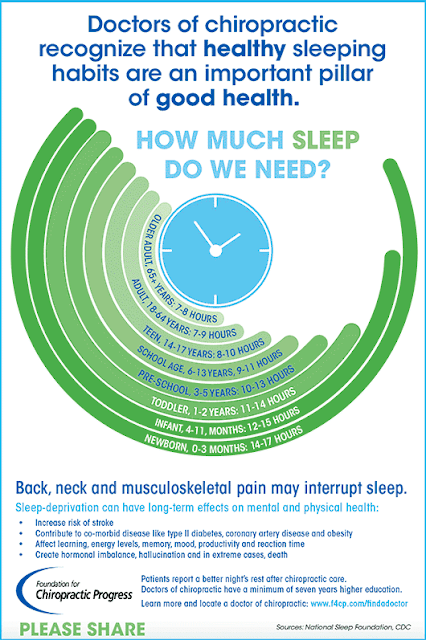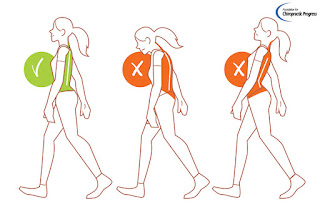 |
| Chiropractor Near Me |
Thursday, October 6, 2016
Chiropractic provides better sleep.
Location: 205 Main St., 15853
205 Main St, Ridgway, PA 15853, USA
Malpractice Insurance Offers Low Rates in Pediatric Chiropractic Care Due to Low Risks
 |
| #ThinkChiropractic |
Malpractice insurance premium
rates are based upon risk – the higher the risk of injury from a given
treatment, the higher the malpractice insurance rates for providers of that specialty.
Doctors of chiropractic who treat children have the same malpractice insurance rates as those who treat
adults, meaning pediatric chiropractic care carries no increased risk.
Doctors of chiropractic have
some of the lowest malpractice insurance rates of all primary health care
providers in the United States (including medical doctors and osteopaths). The
translation: services provided by a doctor of chiropractic carry the lowest
risk of harm.
Source:
Doyle, M.F. Is chiropractic pediatric care safe?
A best evidence topic. Clinical Chiropractic 2011; volume 14, issue 3, pp. 97 –
105.
Labels:
chiropractic care for kids,
chiropractic care near me,
insurance,
malpractice,
pediatric chiropractic care
Location: 205 Main St., 15853
205 Main St, Ridgway, PA 15853, USA
Tuesday, October 4, 2016
Studies Show Chiropractic Care is Utilized by Millions of Children
 |
| #ThinkChiropractic |
Chiropractic
continues to be utilized by millions of children. Pediatric
care has helped countless children from infants through adolescents.
According
to a 2007 study in the journal Pediatrics, the approximate number of annual pediatric
visits to doctors of chiropractic was 30 million. In 2008 and again in 2012, chiropractic/osteopathic
spinal manipulation was the most frequently used complementary service for
children in the U.S. according to the Centers for Disease Control
and Prevention (CDC).
Chiropractic care can help infants and children with various health issues. Pediatric chiropractic
care gives parents the satisfaction of knowing their children are benefiting from
a safe and drug-free treatment.
Sources:
Barnes PM,
Bloom B, et al. Complementary and Alternative Medicine Use Among Adults and
Children: United States, 2007 National Health Statistics Reports. Centers for Disease
Control and Prevention. December 10, 2008, (No. 12).
Kemper KJ,
Vohra S, et al. American Academy of Pediatrics. The Use of Complementary and
Alternative Medicine in Pediatrics. Pediatrics.
2008; 122(6):1374- 1386
Humphreys,
Kim. "Possible Adverse Events in Children Treated by Manual Therapy: A
Review." Chiropractic & Manual Therapies. BioMed Central Ltd, 2 June
2010. Web. 04 Oct. 2016. <http://chiromt.biomedcentral.com/articles/10.1186/1746-1340-18-12>.
Clarke TC,
Black LI, Stussman BJ, Barnes PM, Nahin RL. Trends in the use of complementary
health approaches among adults: United States, 2002–2012. National health
statistics reports; no 79. Hyattsville, MD: National Center for Health
Statistics. 2015.
Location: 205 Main St., 15853
205 Main St, Ridgway, PA 15853, USA
Wednesday, May 18, 2016
New CDC Guidelines Seen as Boost for Chiropractic Care
Sponsored News - Now what?
That’s the question chronic
pain sufferers are asking following the Centers for Disease Control and
Prevention’s release of the first-ever national guidelines designed to curb
the alarming increase in prescription drug deaths.
A
record high 47,055 overdose deaths were recorded in 2014, according to the latest
statistics, which is 6.5% percent higher than the previous year. 61% of
those deaths (28,647) were due to prescription pain killers, which is 14% higher than in 2013! And the
government’s response advising doctors not to prescribe the potentially
addictive pills in most situations for chronic pain couldn’t have been plainer.
“It has become increasingly clear
that opioids carry substantial risk but only uncertain benefits especially
compared with other treatments for chronic pain,” CDC Director Dr. Thomas R. Frieden
told reporters in March.
The one catch? Right now it’s purely voluntary whether
doctors used to prescribing the likes of OxyContin stop or not. So if, for example, you’re concerned about
overdosing and experiencing musculoskeletal
conditions including low back
and neck
pain, many experts say it’s time to consider an alternative like chiropractic care.
Even before the CDC acted,
drug-free chiropractic care was being touted as the go-to first option over
both prescription pills and surgery as a result of research showing it yielded
improved patient outcomes, higher satisfaction, and lower costs. “It’s
heartening to see the growing opioid epidemic is finally gaining the attention
it deserves,” said Sherry
McAllister, DC, executive vice president of the not-for-profit Foundation for Chiropractic Progress,
noting that doctors
of chiropractic have a minimum seven years of higher education and provide
care and rehabilitation on issues ranging from musculoskeletal pain to headaches
to general health concerns.
Learn more at F4CP.com.
CDC
Budget Initiative - 2016
|
Drug
Overdose Prevention (+$53.6 million) [Bookmarks→Overview of Budget Request→Initiatives→Drug
Overdose Prevention]
Drug overdose deaths have
skyrocketed in the past decade, largely because of prescription opioids.
Prescription Drug Overdose (PDO) death rates quadrupled since 1999, claiming
more than 16,000 lives in 2013 alone. Overdose deaths are only part of the
problem—for each death involving prescription opioids, hundreds of people abuse
or misuse these drugs. Emergency department visits for prescription painkiller
abuse or misuse have doubled in the past few years to nearly half a million.
Prescription opioid-related overdoses cost an estimated $20 billion in medical
and work-loss costs each year. Stemming this epidemic is essential to CDC’s
goal of preventing the leading causes of disease, disability, and death.
Equally important is the need to address the alarming rise in overdose death
from illicit drugs such as heroin.
In FY 2016, CDC will build on
state PDO prevention activities initiated in FY 2014–2015, including the PDO
Prevention for States program to be launched in FY 2015. The FY 2016 budget
request includes $5.6 million to support CDC’s efforts to address the troubling
rise in overdose deaths from illicit opioids such as heroin. An additional
increase of $48.0 million above the $20.0 million provided in FY 2015 will
enable CDC to expand the PDO Prevention for States program to fund all 50
states and Washington, D.C. for a truly comprehensive response to the national
epidemic. CDC funding will scale up existing state Prescription Drug Monitoring
Program (PDMP) programs to improve clinical decision-making and to inform
implementation of insurance innovations and evaluation of state-level policies.
In addition, the increased investment will support rigorous monitoring and
evaluation, and improvements in data quality, with an emphasis on delivering
real-time mortality surveillance. CDC also will scale up activities to improve
patient safety by bringing together health systems and health departments to
develop and track pain management and opioid prescribing quality measures in
states with the highest prescribing rates.
Location: 205 Main St., 15853
205 Main St, Ridgway, PA 15853, USA
Tuesday, May 17, 2016
Chiropractic Treatment of Sciatica
Flexion-distraction
therapy is a chiropractic technique that utilizes a multi-function table that
enables the chiropractor to combine decompression with other gentle non-force
spinal adjustment techniques. Flexion-distraction is well suited for patients
who need a lighter touch, such as those recovering from spinal surgery, currently
undergoing rehabilitation, or those with osteoporosis or of an advanced age.
Flexion-distraction
therapy is well researched and has been proven effective for:
- Reducing pressure on the spinal nerves from a disc bulge or herniation
- Increasing spinal motion within the disc and spinal joints
- Improving posture
- A conservative option to surgery for herniated discs known as discectomy. In fact a 2010 randomized clinical study found that spinal manipulative therapy is just as effective for the treatment of most patients experiencing sciatica secondary to lumbar disc herniation, with 60 percent of sciatica patients able to avoid low back surgery by going to a chiropractor.
Location: 205 Main St., 15853
205 Main St, Ridgway, PA 15853, USA
Thursday, May 12, 2016
The Health Benefits of Good Posture
 |
| F4CP |
Good
posture is the position which is attained when the joints are biomechanically
sound and able to move in the direction they are designed to and the spine is
aligned. Maintaining good posture involves learning how to train your body to
move and function where the least strain is placed on bones, joints and soft
tissues. Additionally, a body that is in equilibrium will attain its alignment
and continue proper mobility.
 |
| Benefits of Good Posture |
Posture Checklist
Training
your body to sit upright can be a challenge. Follow this posture checklist to
learn the proper way to sit with good posture:
Good Posture: What can it do for you?
There
are many health benefits associated with having good posture, such as a spike
in self-esteem and self-image, reduced negative mood and increase in
positivity!
Ø Reduce
or prevent abnormal wearing of joint surfaces that could result in degenerative
diseases (Example: Arthritis)
Start today! Practice makes permanent, so practice
great posture throughout your day.
Alexis Lignos
Marketing Director
Foundation for Chiropractic Progress
201-641-1911 x 52
Location: 205 Main St., 15853
205 Main St, Ridgway, PA 15853, USA
Monday, May 9, 2016
TIME Answers the Question: “Are Chiropractors Legitimate?”
Location: 205 Main St., 15853
205 Main St, Ridgway, PA 15853, USA
Subscribe to:
Posts (Atom)

